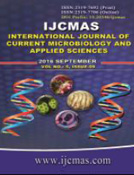


 National Academy of Agricultural Sciences (NAAS)
National Academy of Agricultural Sciences (NAAS)

|
PRINT ISSN : 2319-7692
Online ISSN : 2319-7706 Issues : 12 per year Publisher : Excellent Publishers Email : editorijcmas@gmail.com / submit@ijcmas.com Editor-in-chief: Dr.M.Prakash Index Copernicus ICV 2018: 95.39 NAAS RATING 2020: 5.38 |
Within the genus of Pseudomonas, P. aeruginosa is most frequently associated with human infections. Pseudomonas aeruginosa is regarded as an opportunistic pathogen, primarily causing nosocomial infections in immunocompromised patients. The bacterium is metabolically versatile bacterium that can cause a wide range of severe opportunistic infections in patients with compromised natural defences and serious underlying medical conditions. These infections are characterized by an intense neutrophilic response resulting in significant damage to host tissues and often exhibit resistance to antibiotics leading to mortality. Treatment of persistent infections is additionally hampered by adaptive resistance, due to the growth state of the bacterium in the patient including the microorganism's ability to grow as a biofilm. An array of P. aeruginosa virulence factors counteract host defences and can cause direct damage to host tissues or increase the bacterium's competitiveness. Treatment of infectious diseases becomes more challenging with each passing year. Given the severity of P. aeruginosa infections and the limited antimicrobial arsenal with which to treat them, finding alternative prevention and treatment strategies is an urgent priority. Pseudomonas aeruginosa being the major cause of human illness particularly in hospitalized patients and lack of information on the prevalent types responsible for various infections in this area of Rajasthan, prompted us to undertake the study. The study is done between july 2015 to june 2016 in a Tertiary care hospital of Jhalawar district to find the prevalence and pattern of antibiotic susceptibility of P. aeruginosa.
 |
 |
 |
 |
 |